‘I began my escape from the communist Czechoslovakia 42 years ago, on Sunday, September 1, 1968. According to Wikipedia, I bought several crates of vodka with my winnings at the Akiba Rubinstein Memorial in the Polish spa of Polanica Zdroj, bribed the border guards and drove to West Germany.’ Thus began an article written by Lubomir Kavalek in the Huffington Post in 2010. How curious to write ‘according to Wikipedia’ about oneself! Was this, I speculate, a gentle hint to the reader that the story might be apocryphal?
The Soviet tanks in Prague were decidedly real. Born on 9 August 1943, ‘Lubosh’ Kavalek had studied journalism, and was the reigning chess champion of Czechoslovakia when he defected. Initially, he went to West Germany, where his father already lived, but by 1970 Kavalek had settled in the United States. In 1972, he shared first place at the US Championship, and later that year attended the fabled Fischer–Spassky match in Reykjavik as a journalist for Voice of America. It is clear that Fischer valued his advice, since in the latter part of the match Kavalek unofficially assumed the seconding duties from Bill Lombardy, another American grandmaster. Kavalek wryly noted that for official purposes, he was listed as Fischer’s ‘bowling coach’.
That same decade saw Kavalek briefly reach the world’s top 10. He won the US Championship on two further occasions, and represented the US in seven Olympiads. In 1979 in Montreal he doubled as a co-organiser and participant at the ‘Tournament of Stars’, where his disastrous 1.5/9 start was eclipsed by a remarkable 6.5/9 in the second half, in which he outshone the likes of Tal, Karpov and Spassky.
Later in his career, Kavalek focused on coaching and writing. He was a seasoned coach when he began to work with Nigel Short at the Manila Interzonal in 1990, where Short qualified for the World Championship Candidates. Many credited Kavalek’s guidance as a significant factor in Short’s successful series of matches against Speelman, Gelfand, Karpov and Timman in 1991-1993. (Nonetheless, relations soured and Kavalek was dismissed by Short soon after the start of the 1993 World Championship match against Kasparov in London). His extensive experience as a journalist included 23 years as the chess columnist for the Washington Post, and then at the Huffington Post, a column I often enjoyed reading online. Kavalek died on 18 January, aged 77, at his home in Reston, Virginia.
His most celebrated game is this one, played when he was just 18. After an unusual opening skirmish, Kavalek sacrifices a piece for several pawns to keep the initiative. His remaining pieces are wiped out in a turbulent middlegame, but his eight unscathed pawns march to victory.
Eduard Gufeld–Lubomir Kavalek
Student Olympiad, Marianske Lazne, 1962
1 e4 e5 2 Nf3 Nc6 3 Bb5 Bc5 4 c3 f5 5 d4 fxe4 6 Ng5 Bb6 7 d5 e3! Now Qxg5 is threatened. 8 Ne4 Qh4 9 Qf3 Nf6 10 Nxf6+ gxf6 11 dxc6 exf2+ 12 Kd1 dxc6 13 Be2 Be6 14 Qh5+ Qxh5 15 Bxh5+ Ke7 16 b3 Bd5 17 Ba3+ Ke6 18 Bg4+ f5 19 Bh3 Rhg8 20 Nd2 Bxg2 21 Bxg2 Rxg2 22 Rf1 Rd8 23 Ke2 (see diagram) Rxd2+! I imagine this move being executed with a crunch. 24 Kxd2 e4 25 Bf8 f4 26 b4 Rg5! A brilliant prophylactic measure, preserving the Bb6 at all costs. Instead, 26… e3+ 27 Ke2, or 26…f3 27 Bc5 would put a brake on the pawns. 27 Bc5 Rxc5! 28 bxc5 Bxc5 29 Rab1 f3 30 Rb4 Kf5 31 Rd4 Bxd4 32 cxd4 Kf4 Just in time to support e4-e3+, so White resigns
Got something to add? Join the discussion and comment below.
Get 10 issues for just $10
Subscribe to The Spectator Australia today for the next 10 magazine issues, plus full online access, for just $10.
You might disagree with half of it, but you’ll enjoy reading all of it. Try your first month for free, then just $2 a week for the remainder of your first year.

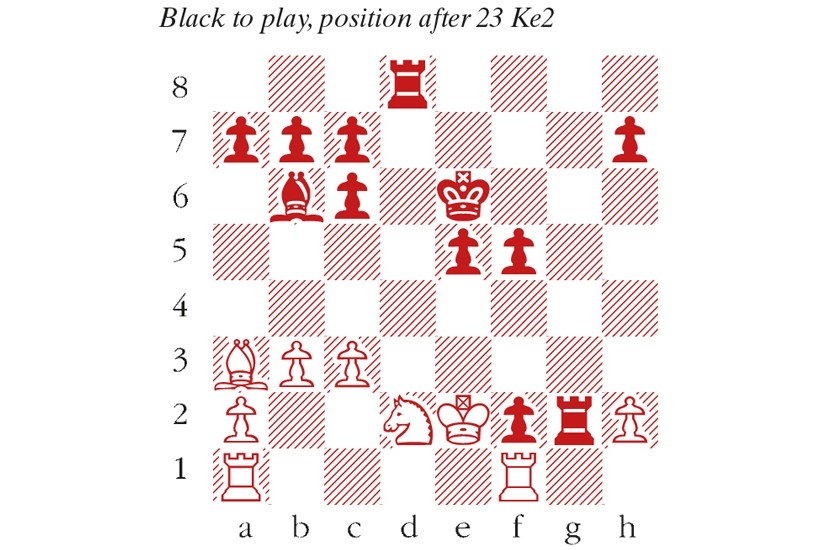
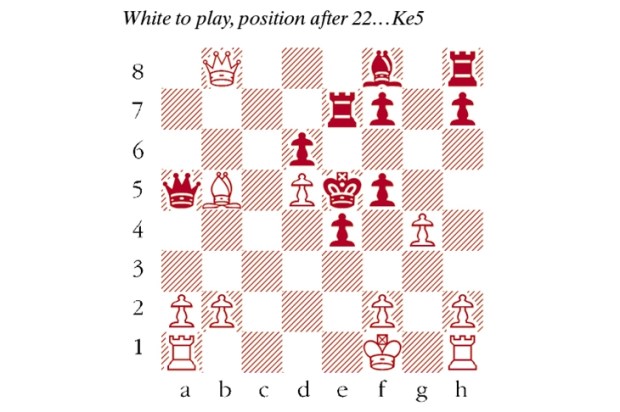
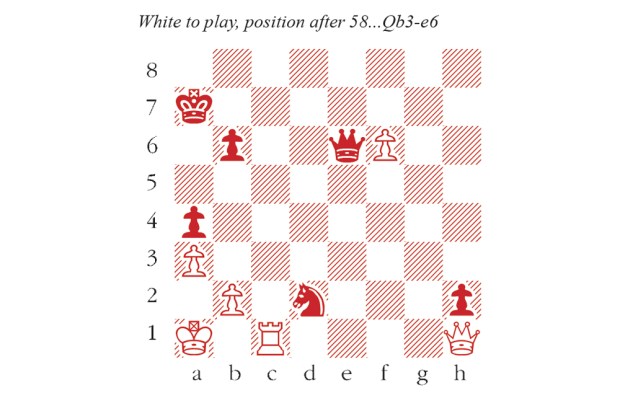
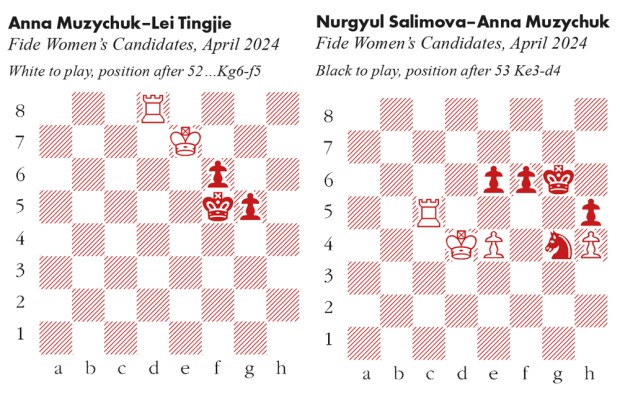
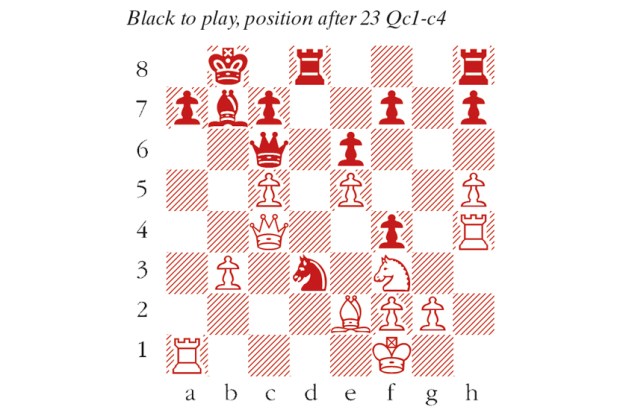
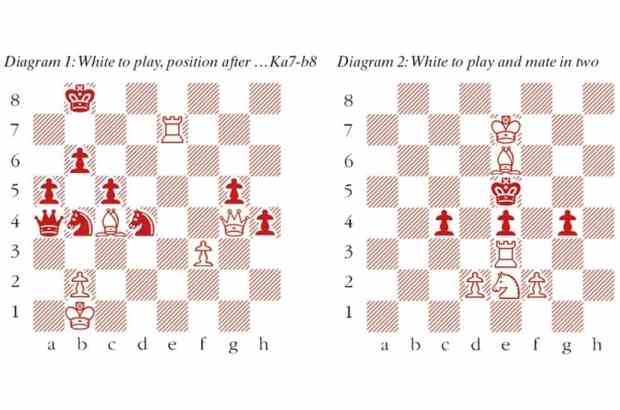
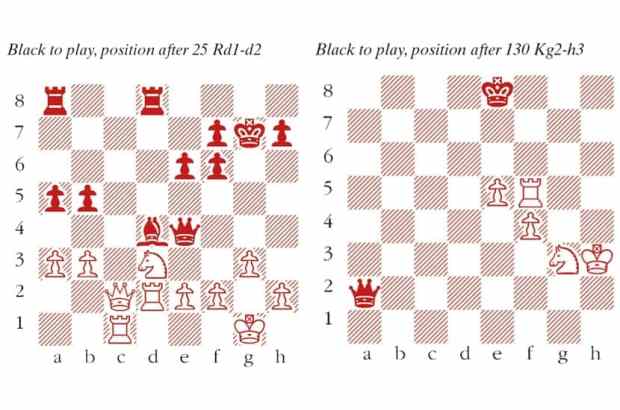






Comments
Don't miss out
Join the conversation with other Spectator Australia readers. Subscribe to leave a comment.
SUBSCRIBEAlready a subscriber? Log in